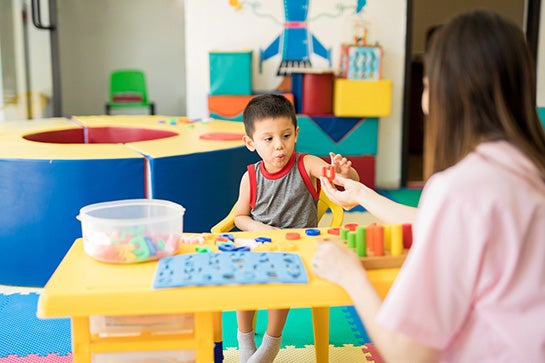Background • Human Subjects Institutional Review Board • ABA Interventions Outcome Research • Recent Publications • Team Members • Hans the Robot • Laboratories • Research Studies • Continuing Education Units • Contact Us
Mission Statement
Easterseals Southern California (ESSC) Research Division conducts state of the art behavioral and scientific research to evaluate and enhance the effectiveness of the interventions that ESSC provides so that individuals with disabilities and their families have equal and better opportunities to live, learn, work, and play in their communities.

Research Division Background
The ESSC Research Division is a sub-branch of ESSC’s Autism Services. The Research Division and the ESSC Human Subjects Institutional Review Board (HSIRB) were launched in November 2014.
The division was developed to conduct research on various aspects of autism treatments and organizational practices in order to inform clinicians, researchers, and the organization.
Many of the ESSC researchers collaborate with a variety of universities around the globe and their publications have been presented at various professional conferences.
The Research Division projects are designed with the primary objective of evaluating short-term and long-term clinical intervention outcomes (clinical research area), staff performance (organizational behavior management area), and experimental research in the field of behavior analysis and psychology (Experimental and conceptual research area).
The research division of Easterseals Southern California (ESSC) serves as an independent research body within Autism Services, to build on the empirical literature related to behavior analysis, psychology, autism, and disability services, thereby informing the broader scientific and clinical community. Any influence the research may have on ESSC’s practices would be at the discretion of individual clinicians and ESSC team members outside of the ESSC Research Division who may be familiar with that research via various channels. The researchers of the ESSC Research Division have no financial, nor otherwise relevant, interests that would impact the research they conduct at ESSC.

Human Subjects Institutional Review Board (HSIRB)
The ESSC HSIRB was developed to oversee ESSC research protocols in order to assure the safety and rights of all research participants.
The ESSC HSIRB consists of a committee of volunteer members with diverse backgrounds, most of whom are not ESSC associates.
The committee comprises parents of children with autism, lawyers, physicians, autism practitioners, educators, and others trained to evaluate adherence of research protocols to federal guidelines for research.
The committee meets once a month and reviews new and active protocols.

Recent Publications
To obtain a pre-print copy, contact our Research Division
2025
Lotfizadeh, A. D., McCoy, E., & Rico, C. (2025). A Comparison of Electronic and Pen-and-Paper Recording in ABA Sessions. Behavioral Interventions. 4(1). https://doi.org/10.1002/bin.70013
2024
Essig Croghan, L., Lotfizadeh, A. D., Edwards, T., & Poling, A. (2024). Motivating operations in the Journal of Organizational Behavior Management: An update. Journal of Organizational Behavior Management. https://doi.org/10.1080/01608061.2024.2411043
Lotfizadeh, A. D., Gard, B., Rico, C., Poling, A., & Choi, K. (2024). Convergent and discriminant validity of the verbal behavior milestones assessment and placement program (VB-MAPP) and the vineland adaptive behavior scales (VABS). Journal of Autism and Developmental Disorders. 10.1007/s10803-024-06241-5
Lotfizadeh, A. D., McCoy, E., & Kazemi, E. (2024). Robots as behavior change agents: Can robots teach behavior technicians to implement differential reinforcement? Behavior Analysis: Research and Practice.
Lotfizadeh, A. D., McCoy, E., Redner, R., & Poling, A. (2024). A point contingency increased webcam usage in a university classroom. Mexican Journal of Behavior Analysis.
2023
Alresheed, F., & Machalicek, W. (2023). A systematic comparison of non-overlap metrics and visual analysis in single-case experimental design. Evidence-Based Communication Assessment and Intervention, 1-19. https://doi.org/10.1080/17489539.2023.2200813
2022
Aranki, J., Wright, P., Pompa-Craven, P., & Lotfizadeh, A.D. (2022). Acceptance of Telehealth Therapy to Replace In-Person Therapy for Autism Treatment During COVID-19 Pandemic: An Assessment of Patient Variables. Telemedicine and e-Health. https://doi.org/10.1089/tmj.2021.0397
Choi, K. R., Lotfizadah, A. D., Bhakta, B., Pompa-Craven, P., & Coleman, K. J. (2022). Concordance between patient-centered and adaptive behavior outcome measures after applied behavior analysis for autism. BMC pediatrics, 22(1), 1-10.
Lotfizadeh, A. D. & Acosta, G. (2022). Evaluation of a Reinforcement Contingency to Increase University Students' Webcam Usage During Online Classroom Instructions. Journal of Behavioral Education. https://doi.org/10.1007/s10864-022-09474-5
Pompa-Craven, P., Tierman, E., Martino, J., & Lotfizadeh, A. D. (2022). Caregiver satisfaction with delivery of telehealth autism services. Advances in Neurodevelopmental Disorders. https://doi.org/10.1007/s41252-022-00256-8
Redner, R., Lotfizadeh, A. D., Edwards, T., & Poling, A. (2022). Resurgence increases with repetition. Behavioural Processes. https://doi.org/10.1016/j.beproc.2022.104620
Sivaraman, M., Fahmie, T., Garcia, A., Hamawe, R., & Tierman, E. (2022). An Evaluation of Ethnicity-Matching for Caregiver Telehealth Training in India. Behavior Analysis in Practice, 1-14.
2021
2020
Lotfizadeh, A. D., Carter, C., Schroeder-MacKay, C., & Poling, A. (2020). Hiring Behavior Analysts: Free Gifts at a Booth Increase Verbal Contacts with a Recruiter, but Not Serious Job Inquiries. Journal of Organizational Behavior Management, 40, 119-128.
2019
Edwards, T., Lotfizadeh, A., & Poling, A. (2019). Motivating operations and stimulus control. Journal of the Experimental Analysis of Behavior. doi: 10.1002/jeab.516
Edwards, T., Lotfizadeh, A. D., & Poling, A. (2019). Rethinking motivating operations: A reply to commentaries on Edwards, Lotfizadeh, and Poling (2019). Journal of the Experimental Analysis of Behavior, 112(1), https://doi.org/10.1002/jeab.542
Haq, S., & Aranki, J. (2019). Comparison of Traditional and Embedded DTT on Problem Behavior and Responding to Instructional Targets. Behavior Analysis in Practice 12,396-400. https://doi.org/10.1007/s40617-018-00324-3
Lotfizadeh, A. D., Herron, M. A., & Poling, A. (2019). Frequency of learning trials presented during trial-by-trial versus first-trial data recording. Behavior Analysis: Research and Practice. Advance online publication. doi: 10.1037/bar0000164
Montallana, K., Gard, B., Lotfizadeh, A. D., & Poling, A. (2019). Inter-rater agreement for the milestones and barriers assessments of the verbal behavior milestones assessment and placement program (VB-MAPP). Journal of Autism and Developmental Disorders, 49. https://doi.org/10.1007/s10803-019-03879-4
Poling, A., Lotfizadeh, A.D., & Edwards (2019). Motivating operations and discriminative stimuli: Distinguishable but interactive variables. Behavior Analysis in Practice. doi: 10.1007/s40617-019-00400-2
2018
Herron, M., Lotfizadeh, A. D., & Poling, A. (2018). Using Conditioned Reinforcers to Improve Behavior-Change Skills: Clicker Training for Practitioners. Journal of Organizational Behavior Management, 38, 172-190.
Lotfizadeh, A. D., Kazemi, E., Pompa-Craven, P., & Eldevik, S. (2018). Moderate effects of low-intensity behavioral interventions. Behavior Modification. doi: 10.1177/0145445518796204.
2017
Poling, A., Lotfizadeh, A.D., & Edwards, T. (2017). Predicting reinforcement: Utility of the motivating operations concept. The Behavior Analyst, 40(1), 49-56.
Prior to 2017
Eilers, H. J., & Hayes, S. C. (2015). Exposure and response prevention therapy with cognitive defusion exercises to reduce repetitive and restrictive behaviors displayed by children with autism spectrum disorder. Research in Autism Spectrum Disorders, 19, 18-31.
Hamad, C.D., Serna, R.W., Morrison, L.A., & Fleming, R. (2010). Extending the reach of early intervention training for practitioners: A preliminary investigation of an online curriculum for teaching behavioral intervention knowledge to families and service providers. Infants and Young Children, 23, 195-208.
Kamps, D., Potucek, J., Dugan, E., Kravits, T., Gonzalez-Lopez, A., Garcia, J., Carnazzo, K., Morrison, L., & Garrison-Kane, L. (2001). Peer training to facilitate social interaction and generalization for elementary students with autism. Exceptional Children, 68 (2), 237-250.

Research Study Participation Opportunities
Click on the links below to see the study flyers.
Background • Human Subjects Institutional Review Board • ABA Interventions Outcome Research • Recent Publications • Team Members • Hans the Robot • Laboratories • Research Studies • Continuing Education Units • Contact Us

